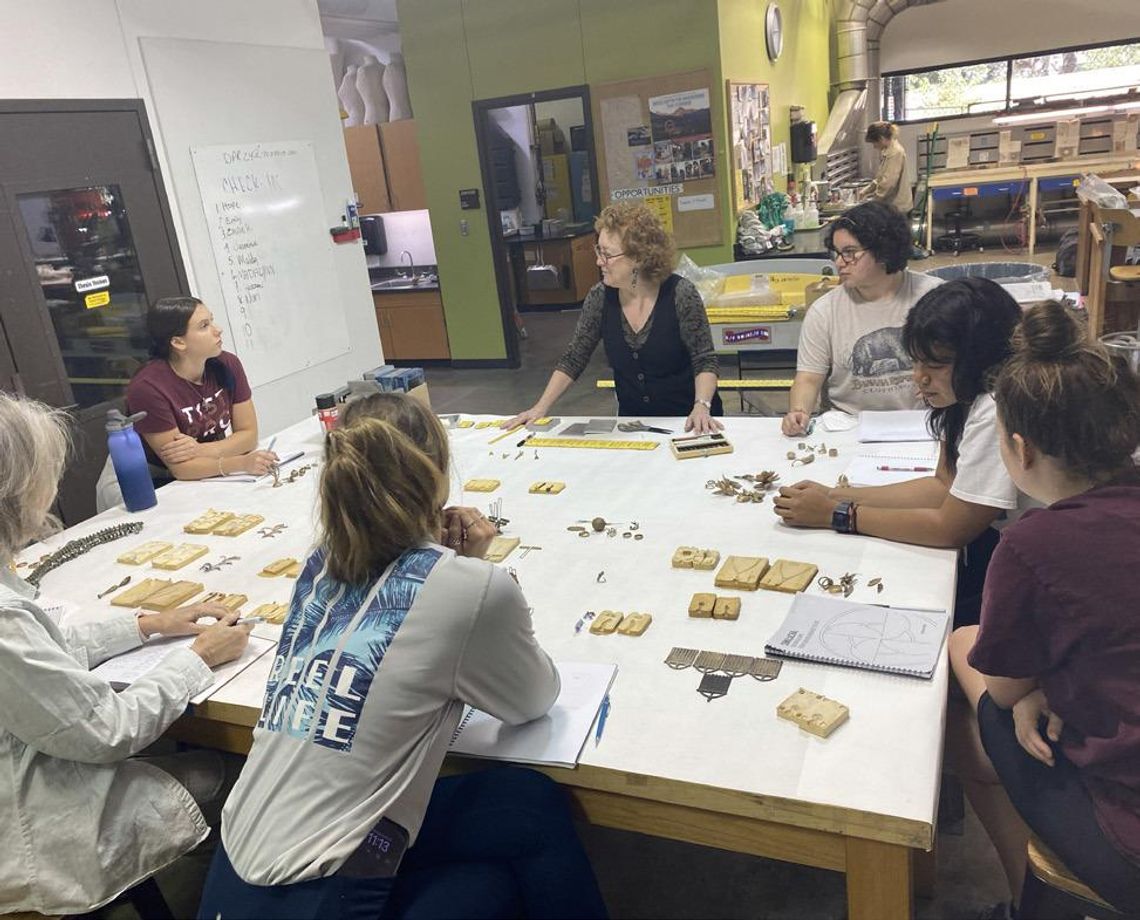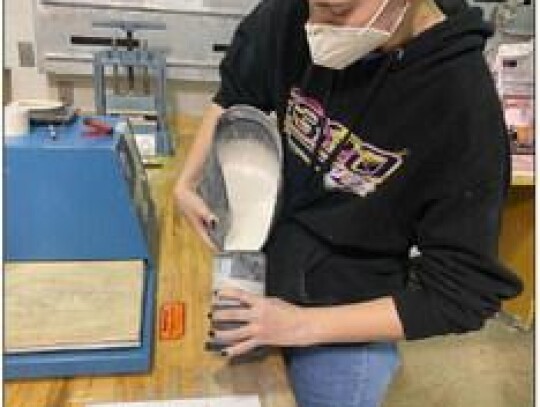Art uses a variety of different mediums to evoke an emotional response in the viewer. One of its forms involves fire and molten metal and is certainly not for the faint of heart. Texas State University has a metals program in their fine arts department and Distinguished Professor Emeritus Beverly Penn is teaching art students to utilize a torch in order to make precious metals even more appealing.
Penn’s love for metals began during a semester-long visit to the University of El Paso where she took her first metals class.
“That’s when I realized that metals was the material that I felt I could be most creative and expressive in,” Penn said. “And that was a turning point for me.”
Penn said although she loves fabrication, forming and soldering, casting is her favorite technique to use, which involves surrounding something that you plan to burn out in the kiln with plaster and using the resulting mold to fill with metal. For example, Penn said she often casts flowers, which means she surrounds them in plaster with the stem sticking out of the plaster in order to provide an entry point for the metal. Then she puts the mold– stem side down–into the kiln and cures the plaster while burning out the plant material, leaving a flower shaped cavity in the plaster.
“I’m really interested in making work that addresses the issues of global warming and climate change,” Penn said. “Casting gives me the ability to be able to make sculptures that are homages to the plant life that we routinely see as lush background wallpaper rather than another living species that are absolutely necessary for us to live on planet earth.”
She said she likes to cast using invasive or maligned species.
I’m doing double duty of helping reduce them in our actual landscape,” Penn said. “But also drawing attention to the plant world in ways that we may not have thought of previously.”
Penn currently has a full exhibition schedule, including an exhibition 'Marking Space, Holding Time,' featuring Texas Women Artists at the Irving Arts Center in which she has contributed six sculptures. She also has two pieces that will be featured in the inaugural grand opening exhibition at the National Museum of Women in the Arts in Washington, D.C.
With Penn’s guidance, the metals program at Texas State has produced many successful artists.
Kit Casati said he creates custom high-end jewelry, sculpture and hero movie props and his work reflects his “passion for nature, sacred geometry, history and process.” He has worked in the film industry for over 17 years and has made bespoke jewelry for many famous people including Tommy Lee Jones, Tom Hanks and Laurence Fishburne, among others.
His work has been featured in Sin City, the Walking Dead and Death Proof along with a lengthy list of other movies and shows. Check out his work at KitCasati. com.
Clint Howard said that he was the teaching assistant for the sculpture department and ran the foundry at the university during his time there. He said he purchased a foundry, now called Pyrology Foundry and Studio, and under his leadership it has progressed to one of the top U.S. facilities of its kind with almost 40 talented artisans. In his personal practice, Howard has made many large scale sculptures, including a life-size moose for the Columbus, Ohio zoo, a fire-fighter for the Bastrop Fire Department, the Buc-ee’s Beaver and a Bison for the Bob Bullock Texas State History Museum. Learn more about Howard’s business at pyrology.com.
Jason Spencer currently practices lost wax casting and reproduction with mold-making techniques, and is employed at the B. Golden Jewelry School in Austin where he teaches those skills.
“I have found it to be a unique way I can assist my community of artists in realizing their designs,” he said.
Spencer also has his own business where he works with designers hanging bespoke wallpaper and said the ability to translate art into a practical trade has enriched his life. Find him on instagram @jason.spencer. art or find him pouring molten metal at B Golden, where he can teach you how to do it yourself.
Sulo Bee is an interdisciplinary metalsmith that uses both fabricated and found objects.
“Couching my subversion to contemporary society in vibrant colors and intricate metal constructions,” Bee said. “I express to others what defines my non-binary.”
Their work can be found at the Galerie Marzee in the Netherlands, Sifuentes Metalsmith in San Antonio, Metalsmith Museum in Memphis, and they have an upcoming solo exhibition on Nov. 11 at Contemporary Craft in Pittsburgh, Pennsylvania. Their work can also be found online at sparklefilth.cloud.
Hannah Wilson said she has worked “as a facilitator of metalsmithing, more so than a maker” and has run multiple jewelry studios, worked for various jewelers, taught and directed jewelry education and continued to make jewelry.
Wilson is currently working as the Production Manager for Jamie Turner Designs—a luxury jewelry line in Austin– managing nine bench jewelers and overseeing various studio manufacturing and production processes. Learn more about Jamie Turner Designs here jamieturnerdesigns.com.
Suzanne Miller McGarraugh said she worked at the San Antonio Museum of Art as a preparator in the Exhibits Department and was the sole artifact mount maker on staff. She began a business in 2000 as an independent contractor doing artifact mount making and installation at museums, which McGarraugh is still doing to this day. Find information on the contract business here museummounts.net.
Josie Mayes said she is the preparator and lead mount fabricator at the Bob Bullock Texas State History Museum in Austin. Mayes performs artifact handling and mount making, installation and deinstallation of all museum objects and artifacts. She said she works primarily in brass for mount fabrication, but also does lighting, woodworking, framing, acrylic bending, design and painting.
Charity Ridpath is an artist and educator in Austin who makes sculptural and production jewelry out of post-consumer waste plastics. Ridpath said that, in addition to small-scale metalsmithing techniques, the jewelry incorporates weaving, sewing and printmaking techniques to transform the waste into natural forms like bugs, mountains and the layers of sedimentary rock. Ridpath’s work can be found at the Contemporary Craft in Pittsburgh, Pennsylvania and Corners Gallery in Ithaca, New York, as well as charityridpath.com.
If you would like to learn more about the mentor herself, there is a book coming out about Penn’s work soon. Beverly Penn Foregrounding, according to the Lisa Sette Gallery website, examines Penn’s 30-year career and features a deep dive into her primary bodies of work and features more than 70 artworks and installations.
Her website is also available at this link: beverlypenn.com.








